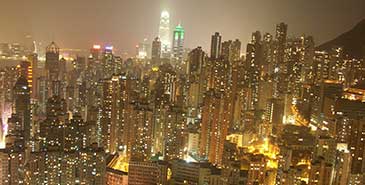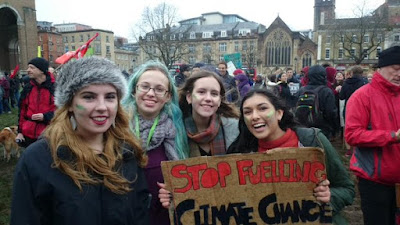We live in a geological age defined by human activity. We live during a time when the landscape of the earth has been transformed by men, its surface paved and cut, its vegetation manipulated, transported and ultimately replaced. A time when the chemical composition of the atmosphere, the rivers and the oceans has been changed – in some ways that are unique for the past million years and in other ways that are unprecedented in Earth history. In many ways, this time is defined not only by our impact on nature but by the redefinition of what it means to be human.
From a certain distance and perspective, the transformation of our planet can be considered beautiful. At night, the Earth viewed from space is a testament to the ubiquitous presence of the human species: cities across the planet glow with fierce intensity but so do villages in Africa and towns in the Midwest; the spotlights of Argentine fishing boats, drawing anchovies to the surface, illuminate the SW Atlantic Ocean; and the flames of flared gas from fracked oil fields cause otherwise vacant tracts of North Dakota to burn as bright as metropolises.
Environmental debates are a fascinating, sometimes frustrating collision of disparate ideas, derived from different experiences, ideologies and perspectives. And we learn even from those with whom we disagree. However, one perspective perpetually bemuses and perplexes me: the idea that it is impossible that man could so transform this vast planet. Of course, we can pollute an estuary, cause the Cuyahoga River to catch fire, turn Victorian London black or foul the air of our contemporary cities. We can turn the Great Plains into cornfields or into dust bowls, the rainforest into palm oil plantations, swamplands into cities and lowlands into nations. But these are local. Can we really be changing our oceans, our atmosphere, our Earth that much?
Such doubts underly the statements of, for example, UKIP Energy Spokesman Roger Helmer:
‘The theory of man-made climate change is unproven and implausible’.
It is a statement characterised by a breathless dismissal of scientific evidence but also an astonishingly naive view of man’s capacity to impact our planet. And it is a statement that has been increasingly echoed by those in the highest echelons of power.
There are places on Earth where the direct evidence of human intervention is small. There are places where the dominance of nature is vast and exhilarating and awe-inspiring. And across the planet, few places are entirely immune from reminders – whether they be earthquakes or volcanoes, tsunamis or hurricanes – that nature is vast and powerful.
But the Earth of the 21st century is a planet shaped by humans.
*********
A powerful example of humanity’s impact on our planet is our Plastic Ocean. We generate nearly 300 billion tons of plastic per year, much of it escaping recycling and much of that escaping the landfill and entering our oceans. One of the most striking manifestations of this is the vast trash vortex in the Northern Pacific Gyre. The size of the vortex depends on assumptions of concentration and is somewhat dependent on methodology, but estimatesrange from 700 thousand square kilometres to more than 15 million square kilometres. The latter estimate represents nearly 10% of the entire Pacific Ocean. Much of the plastic in the trash vortex – and throughout our oceans – occurs as fine particles invisible to the eye. But they are there and they are apparently ubiquitous, with concentrations in the trash vortex reaching 5.1 kg per square km*. That’s equivalent to about 200 1L bottles. Dissolved. Invisible to the eye. But present and dictating the chemistry of the ocean.
More recently, colleagues at Plymouth, Southampton and elsewhere illustrated the widespread occurrence of rubbish, mainly plastic, on the ocean floor. Their findings did not surprise deep sea biologists nor geologists; we have been observing our litter in these supposedly pristine settings since some of the first trips to the abyss.
My first submersible dive was on the Nautile, a French vessel that was part of a joint Dutch-French expedition to mud volcanoes and associated methane seeps in the Mediterranean Sea. An unfortunate combination of working practice, choppy autumn seas and sulfidic sediments had made me seasick for most of the research expedition, such that my chance to dive to the seafloor was particularly therapeutic. The calm of the deep sea, as soon as we dipped below the wave base, was a moment of profound physical and emotional peace. As we sank into the depths, the light faded and all that remained was the very rare fish and marine snow – the gently sinking detritus of life produced in the light-bathed surface ocean.
As you descend, you enter a realm few humans had seen…. For a given dive, for a given locale, it is likely that no human has preceded you.
 |
| Image from Nautile Dive to the Mediterranean seafloor. Shown are carbonate crusts that form where methane has escaped to the seafloor as well as tube worms thriving on the chemical energy available in such settings. Plastic debris has been circled in the upper right corner. |
Mud volcanoes form for a variety of reasons, but in the Mediterranean region they are associated with the tectonic interactions of the European and African continents. This leads to the pressurised extrusion of slurry from several km below the bottom of the sea, along mud diapirs and onto the seafloor. They are commonly associated with methane seeps; in fact a focus of our expedition was to examine the microbes and wider deep sea communities that thrive when this methane is exposed to oxidants at the seafloor – a topic for another essay. In parts of the Mediterranean Sea, they are associated with salty brines, partially derived from the great salt deposits that formed in a partly evaporated ocean about five and a half million years ago.
And all of these factors together create an undersea landscape of indescribable beauty.
On these mud volcanoes are small patches, about 20 cm wide, where methane escapes to the seafloor. There, methane bubbles from the mud or is capped by thick black, rubbery mats of microorganisms. Ringing these mats are fields of molluscs, bouquets of tube worms, great concrete slabs of calcium carbonate or white rims of sulphide and the bacteria thriving on it. Streaming from these seeps, down the contours of the mud cones, are ribbons of ultra-dense, hypersaline water. The rivulets merge into streams and then into great deep sea rivers. Like a photonegative of low-density oil slicking upon the water’s surface, these are white, high-density brines flowing along the seafloor. Across the Mediterranean Sea, they pool into beautiful ponds and in a few very special cases, form great brine lakes.
And two kilometres below the seafloor, where humans have yet to venture our rubbish has already established colonies. Plastic bottles float at the surface of these lakes; aluminium cans lie in the mud amongst the microbial mats; between those thick slabs of calcium carbonate sprout colonies of tube worms and the occasional plastic bag.
We have produced as much plastic in the past decade as we have in the entirety of the preceding human history. But the human impact is not new. On our very first dive, we observed a magnificent amphora, presumably of ancient Greek or Roman origin and nearly a metre across, half buried in the mud.
*********
Today the human footprint is ubiquitous. Nearly 40% of the world’s land is used for agriculture – and over 70% of the land in the UK. Another 3% of the land is urbanised. A quarter of arable land has already been degraded.
There are outstanding contradictions and non-intuitive patterns that emerge from a deeper understanding of this modified planet. Pollinators are more diverse in England’s cities than they are in our rural countryside. One of the most haunting nature preserves on our planet is the Demilitarized Zone between North and South Korea – fraught with landmines but free from humans, wildlife now dominates. And of course, although global warming will cause vast challenges over the coming centuries, that is largely due to one human impact (greenhouse gas emissions) intersecting with another (our cities in vulnerable, low-lying areas and our borders and poverty preventing migration from harm). And on longer timescales, we have likely spared our descendants of 10,000 years from now the hassle of dealing with another Ice Age.
But there can be no doubt or misunderstanding – we have markedly changed the chemical composition of our atmosphere. Carbon dioxide levels are higher than they have been for the past 800,000 years, perhaps the last 3 million years. It is likely that the last time the Earth’s atmosphere contained this much carbon dioxide, glyptodons, armadillo-like creatures the size of cars, roamed the American West, and hominids were only beginning the first nervous evolutionary steps towards what would eventually become humanity. Methane concentrations are three times higher than they were before the agricultural and industrial revolutions. Also higher are the concentrations of nitrous oxides. And certain chlorofluorcarbons did not even exist on this planet until we made them.
The manner in which we have changed our planet has – at least until now – allowed us to thrive, created prosperity and transformed lives in ways that would have astonished those from only a few generations in the past. It is too soon to say whether our collective impact has been or will be, on the whole, either ‘good’ or ‘bad’ for either the planet or those of us who live upon it. It will perhaps never be possible to define such a complex range of impacts in simple black and white terms. But there is no doubt that our impact has been vast, ubiquitous and pervasive. And it is dangerous to underestimate even momentarily our tremendous capacity to change our planet at even greater rates and in even more profound ways in the future.
*Moore, C.J; Moore, S.L; Leecaster, M.K; Weisberg, S.B (2001). “A Comparison of Plastic and Plankton in the North Pacific Central Gyre”. Marine Pollution Bulletin 42 (12): 1297–300. doi:10.1016/S0025-326X(01)00114-X. PMID 11827116.












